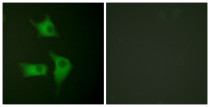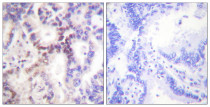ARG66653
anti-p15 INK4b antibody
anti-p15 INK4b antibody for ICC/IF,IHC-Formalin-fixed paraffin-embedded sections,Western blot and Human,Mouse
Overview
| Product Description | Rabbit Polyclonal antibody recognizes p15 INK4b |
|---|---|
| Tested Reactivity | Hu, Ms |
| Predict Reactivity | Rat |
| Tested Application | ICC/IF, IHC-P, WB |
| Host | Rabbit |
| Clonality | Polyclonal |
| Isotype | IgG |
| Target Name | p15 INK4b |
| Antigen Species | Human |
| Immunogen | Synthetic peptide between aa. 60-140 of Human p15 INK4b. |
| Conjugation | Un-conjugated |
| Alternate Names | MTS-2; MTS2; Multiple tumor suppressor 2; p14-INK4b; Cyclin-dependent kinase 4 inhibitor B; TP15; p15INK4B; p15-INK4b; P15; p15INK4b; CDK4I; INK4B |
Application Instructions
| Application Suggestion |
|
||||||||
|---|---|---|---|---|---|---|---|---|---|
| Application Note | IHC-P: Antigen Retrieval: High-pressure and temperature EDTA buffer (pH 8.0). * The dilutions indicate recommended starting dilutions and the optimal dilutions or concentrations should be determined by the scientist. |
||||||||
| Observed Size | ~ 15 kDa |
Properties
| Form | Liquid |
|---|---|
| Purification | Affinity purification with immunogen. |
| Buffer | PBS, 0.02% Sodium azide, 50% Glycerol and 0.5% BSA. |
| Preservative | 0.02% Sodium azide |
| Stabilizer | 50% Glycerol and 0.5% BSA |
| Concentration | 1 mg/ml |
| Storage Instruction | For continuous use, store undiluted antibody at 2-8°C for up to a week. For long-term storage, aliquot and store at -20°C. Storage in frost free freezers is not recommended. Avoid repeated freeze/thaw cycles. Suggest spin the vial prior to opening. The antibody solution should be gently mixed before use. |
| Note | For laboratory research only, not for drug, diagnostic or other use. |
Bioinformation
| Database Links |
Swiss-port # P42772 Human Cyclin-dependent kinase 4 inhibitor B Swiss-port # P55271 Mouse Cyclin-dependent kinase 4 inhibitor B |
|---|---|
| Gene Symbol | CDKN2B |
| Gene Full Name | cyclin-dependent kinase inhibitor 2B (p15, inhibits CDK4) |
| Background | This gene lies adjacent to the tumor suppressor gene CDKN2A in a region that is frequently mutated and deleted in a wide variety of tumors. This gene encodes a cyclin-dependent kinase inhibitor, which forms a complex with CDK4 or CDK6, and prevents the activation of the CDK kinases, thus the encoded protein functions as a cell growth regulator that controls cell cycle G1 progression. The expression of this gene was found to be dramatically induced by TGF beta, which suggested its role in the TGF beta induced growth inhibition. Two alternatively spliced transcript variants of this gene, which encode distinct proteins, have been reported. [provided by RefSeq, Jul 2008] |
| Function | Interacts strongly with CDK4 and CDK6. Potent inhibitor. Potential effector of TGF-beta induced cell cycle arrest. [UniProt] |
| Cellular Localization | Cytoplasm. Note=Also found in the nucleus. [UniProt] |
| Calculated MW | 15 kDa |
Images (5) Click the Picture to Zoom In
-
ARG66653 anti-p15 INK4b antibody ICC/IF image
Immunofluorescence: HeLa cells stained with ARG66653 anti-p15 INK4b antibody. The picture on the right is blocked with the synthetic peptide.
-
ARG66653 anti-p15 INK4b antibody IHC-P image
Immunohistochemistry: Paraffin-embedded Human liver tissue. Antigen Retrieval: High-pressure and temperature EDTA buffer (pH 8.0). Tissue section was stained with ARG66653 anti-p15 INK4b antibody at 1:100 dilution (4°C, overnight).
-
ARG66653 anti-p15 INK4b antibody WB image
Western blot: HeLa cell lysate stained with ARG66653 anti-p15 INK4b antibody at 1:500 dilution.
-
ARG66653 anti-p15 INK4b antibody IHC-P image
Immunohistochemistry: Paraffin-embedded Human kidney tissue. Antigen Retrieval: High-pressure and temperature EDTA buffer (pH 8.0). Tissue section was stained with ARG66653 anti-p15 INK4b antibody at 1:100 dilution (4°C, overnight).
-
ARG66653 anti-p15 INK4b antibody IHC-P image
Immunohistochemistry: Paraffin-embedded Human lung carcinoma tissue stained with ARG66653 anti-p15 INK4b antibody. The picture on the right is blocked with the synthetic peptide.










